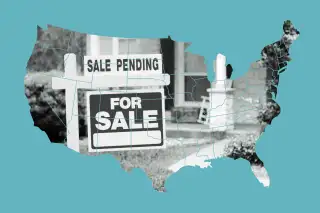This Map Shows What a First-Time Home Buyer Needs to Save for a Down Payment — in Every State

Saving up to buy a first home is never easy. But we have some good news. In many parts of America it's not as hard as you think.
The idea of owning a home can be daunting, especially for millennials, who are buying at a slower rate than the two generations before them did at the same age, according to a 2018 report from the Urban Institute. It’s not because they don’t want to. Americans aged 25 to 34 prioritize buying a house over other major life expenses (getting married, having a kid), but simply can’t afford to.
Of course, one reason is their preference for coastal cities like San Francisco and New York. But while these already-expensive markets become pricier, first-time buyers can look to other parts of the country to up their chances of becoming homeowners.
In 2018, the median sales price of a house in the U.S. was $265,500, according to data provided by real estate property company Attom Data Solutions. Going by the traditional down payment rate of 20% — a rule of thumb established by the government in the last century to help maintain manageable monthly mortgage payments — a buyer would have to put down $53,100 for a median-priced house.
Fortunately, you don't need to put 20% down, and in fact most young buyers don't do anywhere near that much. Those financing their first home typically pay about 7% of the sales price, according to a survey by The National Association of Realtors (NAR), and even have the opportunity to put down less than that.
With 7% down, Americans would need about $18,585 to buy a typical home, but the amounts vary from state-to-state. In California, Hawaii, and the District of Columbia, for example, where half of all houses sell for over half a million dollars, 7% is anywhere from $35,000 to $41,000. That's enough send your kid to private school for three or four years.
But in the majority of Midwestern and southeastern states, namely Arkansas, West Virginia, and Oklahoma, houses sell for much less. A 7% rate only comes out to about $10,000 to $12,000 — roughly the price of a used Chevy.
The 20% Down Payment Rule
To be sure, the 20% rule does make a lot of sense if you can afford it. It can help you get the lowest possible interest rate on your mortgage and means you can bypass the monthly mortgage insurance fee (private mortgage insurance, or PMI) that a buyer has to pay until they reach the 20% mark.
It also gives you an important cushion if home values fall. Without that cushion, declining house prices can leave you owing more on your mortgage than the value of your home. That predicament, known as being "underwater" is what happened to many young homebuyers during the financial crisis.
First-Time Home Buyers
But for some young families, adhering to the 20% rule means being shut out of the market altogether, and many housing experts think starting out with a lower payment is worth the extra costs — and the extra risks.
Fortunately for first-time buyers, federal- and state-backed programs like the Federal Housing Administration (FHA) loan allow much lower rates — even lower than the now-typical 7%. With an FHA loan, a down payment can be as low as 3.5%, given the buyer meets a certain set of requirements, like having PMI. Other programs even offer 0% down for military families and rural area homebuyers.
If you borrow responsibly, a low-down payment loan could mean the first step towards owning your first home — a step that doesn't involve selling everything else you own to get there.